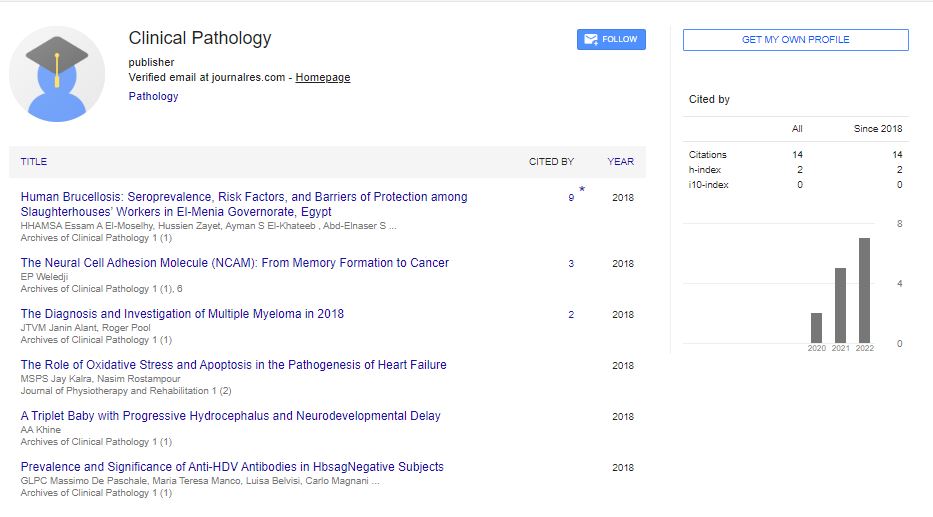Commentary, Arch Clin Pathol Vol: 6 Issue: 4
Cellular Insights: The Significance of Anatomical Pathology in Healthcare Evolution
Mark Evelyn*
1Department of Medicine, University of Verona, Verona, Italy
*Corresponding Author: Mark Evelyn,
Department of Medicine, University of
Verona, Verona, Italy
E-mail: markevelyn@uni.edu
Received date: 27 November, 2023, Manuscript No. ACPY-24-124233;
Editor assigned date: 29 November, 2023, PreQC No. ACPY-24-124233 (PQ);
Reviewed date: 13 December, 2023, QC No. ACPY-24-124233;
Revised date: 21 December, 2023, Manuscript No. ACPY-24-124233 (R);
Published date: 29 December, 2023 DOI: 10.4172/acpy.100097
Citation: Evelyn M (2023) Cellular Insights: The Significance of Anatomical Pathology in Healthcare Evolution. Arch Clin Pathol 6:4.
Description
Anatomical pathology is a specialized branch of medicine that investigates the structural and functional changes within tissues and organs to diagnose diseases. Anatomical pathology plays a pivotal role in understanding diseases by examining tissues and cells under a microscope. The discipline encompasses various techniques and methodologies to analyze and interpret changes at the cellular and tissue levels. The origins of anatomical pathology date back to ancient times, with initial observations of tissue changes made by early physicians like Hippocrates and Galen. However, it wasn't until the development of the microscope in the 17th century that significant advancements occurred. Rudolf Virchow, often referred to as the father of modern pathology, pioneered the concept that diseases originate at the cellular level, laying the foundation for anatomical pathology as we know it today.
Fundamentals of anatomical pathology
Anatomical pathology involves various techniques such as gross examination, histology, cytology, immunohistochemistry, and molecular pathology. Gross examination involves the macroscopic analysis of tissues and organs during autopsies or surgical procedures. Histology and cytology employ microscopic examination to study cellular and tissue structures, aiding in the identification of abnormalities indicative of diseases. Immunohistochemistry utilizes specific antibodies to identify proteins within tissues, allowing for the characterization of tumors and other pathological conditions. Molecular pathology involves the study of genetic and molecular alterations contributing to disease development, offering insights into personalized treatment strategies.
Role in disease diagnosis and treatment
Anatomical pathology is integral to diagnosing various diseases, including cancer, infectious diseases, autoimmune disorders, and congenital abnormalities. Accurate diagnosis relies on the precise identification and interpretation of tissue changes. Pathologists collaborate with clinicians to provide accurate diagnoses crucial for determining treatment plans, prognosis, and patient management.
Cancer diagnosis heavily relies on pathological assessments, aiding in tumor classification, grading, and identification of therapeutic targets. Additionally, anatomical pathology plays a crucial role in monitoring treatment responses and disease progression through follow-up examinations.
Emerging trends and innovations
The landscape of anatomical pathology continues to evolve with technological advancements. Digital pathology, utilizing digital imaging and analysis, facilitates remote diagnostics and enhances collaboration among pathologists worldwide. Artificial intelligence and machine learning are being integrated into pathology workflows, aiding in pattern recognition, diagnosis, and predictive analytics. Moreover, liquid biopsy techniques, detecting biomarkers in bodily fluids, show promise in non-invasive disease monitoring.
Challenges and future directions
Despite its advancements, anatomical pathology faces challenges such as workforce shortages, increasing workloads, and the need for continuous education to adapt to evolving technologies. Integrating complex datasets from multiple sources poses challenges in data management and standardization. The future direction of anatomical pathology involves leveraging automation, enhancing interdisciplinary collaborations, and integrating multi-omics data to achieve precise and personalized diagnostics and therapeutics.
Conclusion
Anatomical pathology stands as an indispensable pillar in modern medicine, unraveling the complexities of diseases at the microscopic level. Its methodologies, ranging from traditional histopathology to cutting-edge molecular analyses, continue to drive advancements in diagnostics, treatment, and research. As technology evolves and knowledge expands, the field of anatomical pathology is poised to play an increasingly pivotal role in shaping the future of healthcare.
 Spanish
Spanish  Chinese
Chinese  Russian
Russian  German
German  French
French  Japanese
Japanese  Portuguese
Portuguese  Hindi
Hindi 